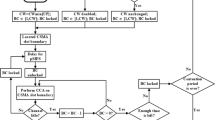Abstract
The dynamic nature of IEEE802.11 Wireless LAN network poses several challenges in developing a contention resolution scheme. A contention control algorithm guarantees maximum channel throughput by reducing collisions and improves the fairness among competing nodes. Based on the local history and neighbouring station’ status, a new algorithm namely Channel Status based Sliding Contention Window (CS-SCW) algorithm is proposed in this paper to adopt the optimum contention window interval. In the proposed algorithm, a fuzzy controller is used to infer about the current channel condition and to regulate the random access in network. Simulation results confirm the enhanced performance of the proposed CS-SCW algorithm in terms of success rate, packet loss, fairness index and energy consumption.




















Similar content being viewed by others
References
Abdelkader T, Naik K (2014) A localized adaptive strategy to calculate the backoff interval in contention-based vehicular networks. IEEE Access 2:215–226
Alekhya TNVL, Mounika B, Jyothi E, Bhandari BN (2012) A waiting-time based backoff algorithm in the IEEE 802.11 based wireless networks. IEEE national conference on communications (NCC), pp 1–5
Baklizi M, Abdel-Jaber A, Abu-Shareha A, Abualhaj MM, Ramadass S (2014) Fuzzy logic controller of gentle random early detection based on average queue length and delay rate. Int J Fuzzy Syst 16(1):9–19
Bi S, Zhang YJ (2012) Mitigating power law delays: the use of polynomial backoff in IEEE 802.11 DCF, IEEE international conference on communications (ICC), pp 2510–2515
Bononi L, Conti M, Gregori E (2004) Runtime optimization of IEEE 802.11 wireless LANS performance. IEEE Trans Parallel Distrib Syst 15(1):66–79
Brenner P (1997) A Technical tutorial on the IEEE 802.11 protocol. BreezeCOM Wireless Communications, pp 1–24
Chang WJ, Chen PH, Yang CT (2013) Robust fuzzy congestion control of TCP/ACM router via perturbed Takagi–Sugeno fuzzy models. Int J Fuzzy Syst 15(2):203–213
Chen J, Wu W (2004) Dynamic contention window selection scheme to achieve a theoretical throughput limit in wireless networks: a fuzzy reasoning approach. IEEE 60th vehicular technology conference. VTC2004-Fall 2004, 5, pp 3196–3200
Chrysostomou C, Djouvas C, Lambrinos L (2011) Applying adaptive QoS-aware medium access control in priority-based vehicular ad hoc networks. IEEE symposium on computers and communications (ISCC), pp 741–747
Chrysostomou C, Djouvas C, Lambrinos L (2012) Dynamically adjusting the min-max contention window for providing quality of service in vehicular networks. Ad hoc networking workshop (Med-Hoc-Net), 2012. The 11th annual Mediterranean, pp 16–23
Deng D-J (2011) PSSB: priority enforced slow-start backoff algorithm for multimedia transmission in wireless ad-hoc networks. J Netw Comput Appl 34(4):1468–1473
Janseen JAEB, Krol MS, Schielen RMJ, Hoekstra AY, Kok JL (2010) Assessment of uncertainties in expert knowledge, illustrated in fuzzy rule based models. Ecol Model 221(9):1245–1251
Jingqi F, Qiang Z, Haikuan W (2009) A new backoff algorithm based on the dynamic modulating parameters of IEEE 802.11. 5th international conference on wireless communications, networking and mobile computing, pp 1–4
Kim Y-J, Lee J-O, Lim M-T (2006) Evaluation of the distributed fuzzy contention control for IEEE 802.11 wireless LANs. Knowledge-based intelligent information and engineering systems. Lecture notes in computer science, vol 4253, pp 225–232
Kim Y-J, Lim M-T (2005) Run-time fuzzy optimization of IEEE 802.11 wireless LANs performance. Lecture notes in computer science, pp 1079–1088
Klir GJ (1997) Fuzzy sets and fuzzy logic: theory and applications. Prentice Hall, USA
Li T, Tang T, Chang C (2009) A new backoff algorithm for IEEE 802.11 distributed coordination function. Sixth international conference on fuzzy systems and knowledge discovery, vol 3, pp 455–459
Natkaniec M, Kosek-Szott K, Szott S, Bianchi G (2013) A survey of medium access mechanisms for providing QoS in ad-hoc networks. IEEE Commun Surv Tutor 15(2):592–620
Rizk MRM, Dessouky MI, El-Dolil SA, Abd-Elnab M (2009) A novel fair random access scheme with throughput optimization using fuzzy controller for wireless systems. Int J Netw Manag 19(4):305–314
Rizk MRM, Dessouky MI, El-Dolil SA, Abd-Elnaby M (2011) Efficient contention-based MAC protocol using adaptive fuzzy controlled sliding backoff interval for wireless networks. Comput Electr Eng 37(1):115–125
Sakakibara K, Taketsugu J (2010) A new IEEE 802.11 DCF utilizing freezing experiences in backoff interval and its saturation throughput. J Commun Netw 12(1):43–51
Schiller JH (2009) Mobile communication, 2nd edn. Addison Wesley Publisher, London
Sugeno M, Kang GT (1988) Structure identification of fuzzy model. Fuzzy Sets Syst 28:15–33
Yassein MB, Manaseer SS, Momani AA (2012) Adaptive backoff algorithm for wireless internet. Int J Emerg Technol Web Intell 4(2):155–163
Yi S, Ying W, Liangrui T (2012) An improved algorithm based on fuzzy theory for 802.11 DCF. International conference on fuzzy systems and knowledge discovery (FSKD), pp 536–539
Zhai H, Wang J, Chen X, Fang Y (2006) Medium access control in mobile ad hoc networks: challenges and solutions. Wirel Commun Mobile Comput 6(2):151–170
Zhang X, Li N, Zhu W, Sung DK (2009) TCP transmission rate control mechanism based on channel utilization and contention ratio in ad hoc networks. IEEE Commun Lett 13(4):280–282
Author information
Authors and Affiliations
Corresponding author
Ethics declarations
Conflict of interest
The authors declare that they have no conflict of interest.
Additional information
Communicated by V. Loia.
Rights and permissions
About this article
Cite this article
Nithya, B., Mala, C. & Sivasankar, E. Channel Status based Sliding Contention Window (CS-SCW) algorithm: A Fuzzy Control Approach for Medium Access in Wireless Networks. Soft Comput 21, 1991–2004 (2017). https://doi.org/10.1007/s00500-015-1894-z
Published:
Issue Date:
DOI: https://doi.org/10.1007/s00500-015-1894-z




